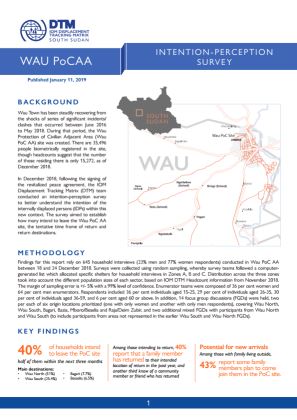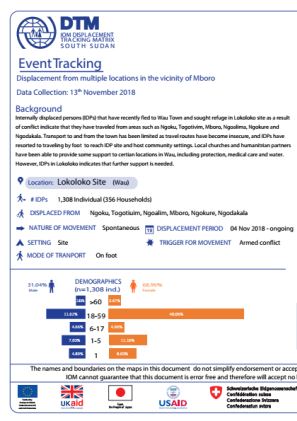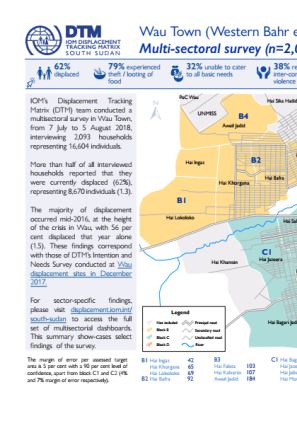-
Countries
-
Data and Analysis
-
Special Focus
-
Crisis Responses
South Sudan
South Sudan
IDPs tracked
Displacement Movements
1,121,000
IDMC 2023
Data collection round
About South Sudan
Conflict and instability in South Sudan have resulted in large-scale internal and cross-border displacement since the December 2013 crisis of over 4 million individuals. In September 2018, the Revitalized Agreement for the Resolution of the Conflict in South Sudan (R-ARCSS) was signed between the major warring parties. Whilst overall there have been improvements in security since and returns are ongoing, fighting and communal clashes (frequently linked to cattle raiding) continue to trigger new displacements and the situation remains volatile.
DTM South Sudan’s toolbox is designed to meet critical information gaps during all phases of response, from preparedness, to intervention and transition/recovery. DTM South Sudan provides country-wide figures on the numbers, locations and priority needs of IDPs and returnees updated on a quarterly and ad-hoc basis. The programme undertakes biometric registration in selected parts of the country to support partners with reaching intended beneficiaries during distributions. Flow monitoring data is collected on a daily basis at displacement sites, key transit hubs and border crossing points to identify mobility dynamics of migrants including IPDs and returnees. Through ad hoc surveys, headcounts, infrastructure/service mapping exercises and other assessments, DTM provides additional information to support partners in planning their response.
Contact
IOM South Sudan DTM Juba
ISSDTM@iom.int
Current Donors
- Switzerland
- Japan
- DFID
- ECHO
- OCHA
- OFDA
- Canada (DFATD)
- WFP
- UN Peacebuilding Fund
- World Bank
South Sudan — Intentions and Perception Survey – Wau PoC AA (December 2018)
Findings of an intention-perception survey conducted in the Wau PoC AA site (Western Bahr El Ghazal) by IOM-DTM in coordination with CCCM between mid-December 2018 and beginning of January 2019.
South Sudan — Uganda / South Sudan Flow Monitoring (April - October 2018)
IOM DTM measures mixed migration along the Ugandan (UGA) border through four strategically located flow monitoring points (FMPs). Over 90 per cent of persons observed at these points are South Sudanese.
South Sudan — Event Tracking: Wau Lokoloko (Nov. 2018)
Internally displaced persons (IDPs) that have recently fled to Wau Town and sought refuge in Lokoloko site as a result of conflict indicate that they have traveled from areas such as Ngoku, Togotivim, Mboro, Ngoalima, Ngokure and Ngodakala.
South Sudan — Biometric registration update: Wau Cathedral Site (October 2018)
In the Cathedral Collective Centre of Wau Town, DTM in coordination with WFP undertook a card conversion exercise, registering a total of 18,209 individuals corresponding to 4,569 households from 29 September to 5 October 2018.
South Sudan — Multisectoral Needs Survey – Wau (August 2018)
Commissioned on behalf of the International Organization for Migration’s Shelter team, the multi-sectoral survey seeks to inform humanitarian partners and transition/recovery actors of gaps in services and the needs of populations in Wau Town.
South Sudan — Biometric registration update: Bor PoC Site (September 2018)
The International Organization for Migration (IOM), in cooperation with ACTED, in support of the World Food Programme (WFP) and other partners, conducted a biometric registration (BMR) exercise at Bor Protection of Civilians Site (Jonglei) from 13 to 15 September 2018.
South Sudan — Wau Multi-Sector Assessment Dashboard: G. Health (July-August 2018)
IOM DTM conducted a multi-sectoral assessment interviewing 2,093 households in Wau (Western Bahr el Ghazal). This dashboard provides a preliminary overview of Health related findings.
South Sudan — Wau Multi-Sector Assessment Dashboard: F. Shelter / NFI (July-August 2018)
IOM DTM conducted a multi-sectoral assessment interviewing 2,093 households in Wau (Western Bahr el Ghazal). This dashboard provides a preliminary overview of Shelter / NFI related findings.
South Sudan — Wau Multi-Sector Assessment Dashboard: E. WASH (July-August 2018)
IOM DTM conducted a multi-sectoral assessment interviewing 2,093 households in Wau (Western Bahr el Ghazal). This dashboard provides a preliminary overview of WASH related findings.
South Sudan — Wau Multi-Sector Assessment Dashboard: D. Protection (July-August 2018)
IOM DTM conducted a multi-sectoral assessment interviewing 2,093 households in Wau (Western Bahr el Ghazal). This dashboard provides a preliminary overview of protection related findings.
South Sudan — Wau Multi-Sector Assessment Dashboard: C. Livelihoods (July-August 2018)
IOM DTM conducted a multi-sectoral assessment interviewing 2,093 households in Wau (Western Bahr el Ghazal). This dashboard provides a preliminary overview of livelihood related findings.
South Sudan — Wau Multi-Sector Assessment Dashboard: B. Food Security (July-August 2018)
IOM DTM conducted a multi-sectoral assessment interviewing 2,093 households in Wau (Western Bahr el Ghazal). This dashboard provides a preliminary overview of food security related findings.
South Sudan — Wau multi-sector assessment dashboard: A. Demographics (July-August 2018)
IOM DTM conducted a multi-sectoral assessment interviewing 2,093 households in Wau (Western Bahr el Ghazal). This dashboard provides a preliminary overview of the demographics and displacement related findings.
South Sudan — Mobility Tracking Round 2: Kapoeta South Focus (April — June 2018)
Through Mobility Tracking, DTM is able to provide a comprehensive baseline and regular updates on the trends and changes in numbers, locations and priority needs of IDPs and returnees in South Sudan.
South Sudan — Abyei Long-Term Flow Monitoring Update (December 2017 — June 2018)
IOM DTM is measuring migration to and from Sudan passing through Abyei Town (Amiet Market). Migration to Sudan has been 4.5 times higher than movement from Sudan into South Sudan during the reporting period, December 2017 to June 2018.
South Sudan — Event Tracking: Abyei (August 2018)
In mid-July, armed attacks in the Dungop in Abyei led to the displacement of 150 individuals (30 households) to Abyei’s Ameth Aguok region.
South Sudan — Event Tracking: Tambura (4—6 July 2018)
Since the end of May, conflict between government and opposition forces has led to IDPs fleeing to Tambura from the Nagero area. Travel routes are unsafe, and IDPs have resorted to traveling by foot to reach IDP sites.
South Sudan — Event Tracking: Yambio (4—6 July 2018)
Internally displaced persons (IDPs) that have recently fled to Yambio town as a result of conflict indicate that they have traveled from areas such as Saura, Makporo, Mamamo, Bazumburu, and Rimenze (Yambio Payam).
South Sudan - Biometric registration update- Panyijar (July 2018)
The International Organization for Migration’s Displacement Tracking Matrix (IOM DTM), in partnership with the World Food Programme (WFP), local authorities and other partners, conducted a biometric registration (BMR) exercise in Nyal and Ganyiel towns between 28 June and 10 July, 2018 as per the re
South Sudan — Malakal PoC Flow Monitoring: Long-Term Trend Analysis (July 2017 — March 2018)
Malakal PoC site stands out as having consistently witnessed a larger inflow of people than outflow. During the nine-month reporting period, 5,297 individuals (2,384 households) were recorded entering and 543 individuals exiting (202 households).
South Sudan — Wau PoC AA Flow Monitoring: Long-Term Trend Analysis (July 2017 - March 2018)
DTM recorded a total of 2,539 individuals entering and 1,943 individuals exiting Wau’s Protection of Civilians Adjacent Area (PoC AA) site during the reporting period.
South Sudan — Bentiu PoC Site Flow Monitoring: Long-Term Trend Analysis
With a larger population than Malakal and Wau PoC combined, Bentiu PoC site has witnessed the largest net population flow in and out of its gates during the nine-month reporting period.
South Sudan — Mobility Tracking Report 2 (20 July 2018)
Through mobility tracking, DTM is able to provide a comprehensive baseline and regular updates on the trends and changes in numbers, locations and priority needs of IDPs and returnees in South Sudan.
South Sudan — Population count: Bentiu (May 2018)
Internally Displaced Persons (IDPs) have been sheltering at the Bentiu protection of civilian (PoC) site since December 2013. There are currently 114,652 IDPs seeking protection in the site.
Pagination
Pagination
- First page
- Previous page
- 1
- 2
- 3
- 4
- 5
- 6
Pagination
- First page
- Previous page
- …
- 13
- 14
- 15
- 16
- 17
- 18
- 19
- 20
- 21




















